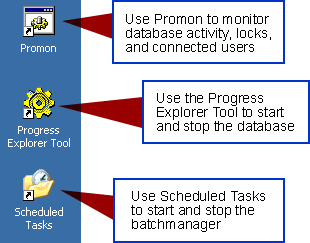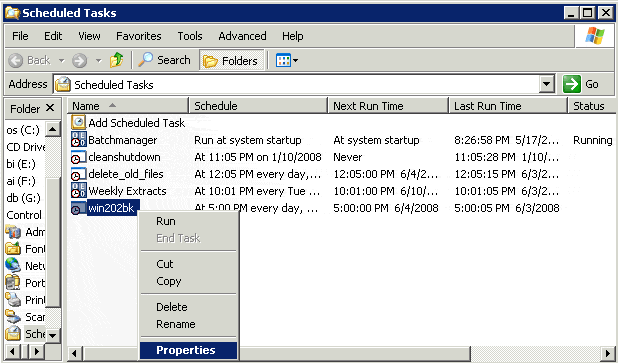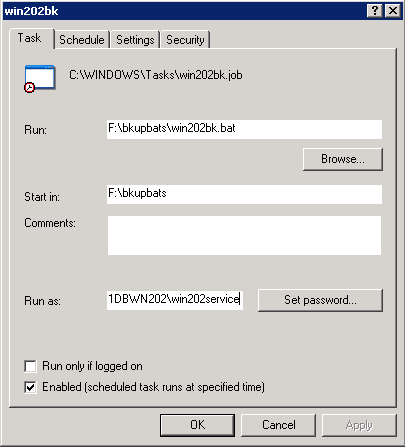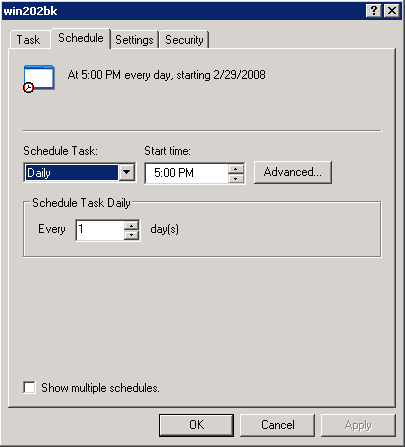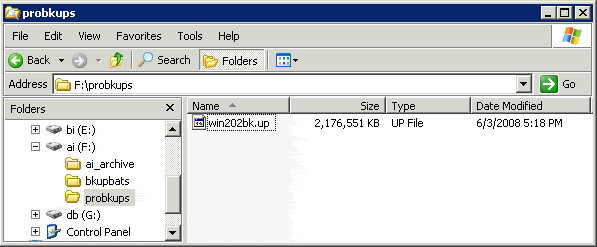Home → Contents → Introduction → Data Entry Screens → Screens → Quarterly Processing → Lookup Tables → Administrative → Reports → Server Information → Appendices
Chapter 8: WIN-202 Server Information
This section is focused primarily toward technical staff or those with administrative privileges that maintain the WIN-202 system. The three tools discussed in the following sub-sections include Promon, ProControl and Scheduled Tasks. Please note that this section is not intended to be a complete reference to Progress database management, but covers common processes useful to system administrators. Refer to the "Progress System Administration Reference" handbook for a complete and detailed reference guide.
Promon (Progress Monitor)
The Promon utility is an extremely useful tool for monitoring database and system activity. With Promon, system administrators can determine who is on the system, what kinds of locks are being held, system usage, if the batch manager is running, etc. To access this utility double-click the Promon icon on your desktop server. Note: If the icon is not on the desktop, right-click the desktop and select "New Shortcut". In the target type: C:\progress\openedge\bin\promon.bat [path to the database]\win202.
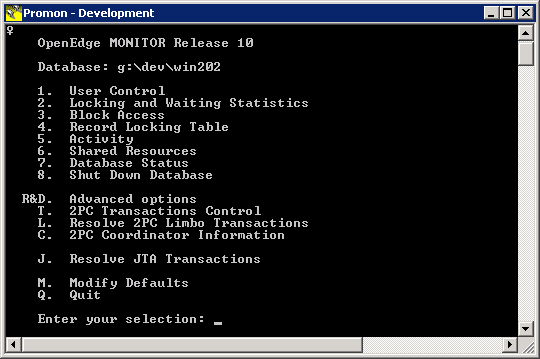
Although state database administrators should familiarize themselves with all of the options, the choices most often used are Option 5 (Activity) and Option 8 (Shut Down Database). These options are discussed below.
Promon Option 5: Activity
Selecting Option 5 on the Progress Monitor (Promon) opens the screen shown below. The screen displays how your database is performing at one moment in time. In the following example, the screen is for a sample time frame of 257 hours, 42 minutes and 39 seconds as shown at the top of the screen. The first time you bring up the screen, the data is for the period of time since the database was last started. Every time you hit return, via the [Enter] key on your keyboard, the screen displays system activity since the last time you viewed data.
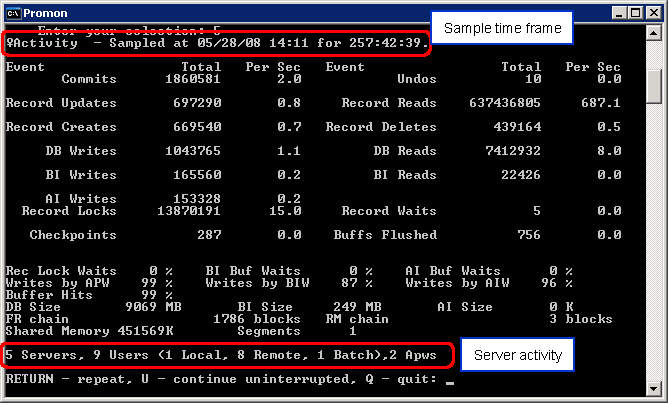
This screen shows a variety of information including:
- How many commits occurred in the database in the specified amount of time
- How many updates occurred
- How many creates occurred
- How many reads occurred
- How many deletes occurred
You can find out whether your Batch Manager is running by looking at the second to the last line on the screen (see previous figure). This line shows the total number of users—in our example, it is nine. It further breaks down those users by type. A local user is running on the server. This most likely is the Watchdog utility, which detects processes that have terminated improperly and cleans up after them. The eight remote users are analysts, connecting remotely from their workstations. The Batch user is the Batch Manager. This line also shows two Asynchronous Page Writers (Apws) active on the database at this time. APWs are optional, but highly recommended since they improve database performance. For more information on Watchdog and APWs, see your Progress System Administration Guide. You can get a detailed listing of these users by selecting Option 8 (Shut Down Database) on the initial "Promon" screen described below.
Promon Option 8: Shut Down Database
Selecting Option 8 from the initial "Promon" screen displays the screen shown below. This screen shows the Batch Manager (shown as CON:, in this case user 6), a Before-Image Writer (BIW), the Watchdog (WDOG), two Asynchronous Page Writers (APW), and eight remote users. The BIW is optional, but highly recommended for improving system input/output performance. For more information on APWs, BIW, and Watchdog, see your Progress System Administration Guide. This screen also gives you the option to disconnect a user, perform an unconditional shutdown, or an emergency shutdown. Note: You must be logged-in as the "win202service" account to be able to disconnect a user.
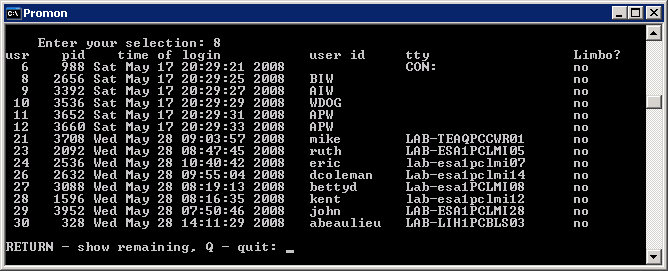
Progress Explorer Tool
The Progress Explorer Tool replaces ProControl. It provides a graphical interface allowing you to manage and configure the WIN-202 server host environment interactively. The tool is most commonly used for starting and stopping the WIN-202 database.
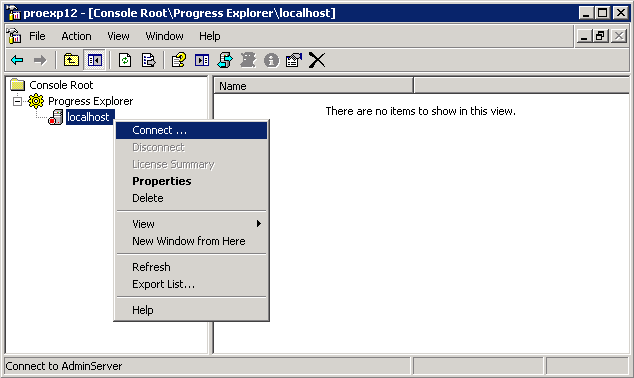
Stop and Start the Database
Double-click the Progress Explorer Tool icon on your WIN-202 desktop server. Right-click the "localhost" and select "Connect" from the menu (see above figure). Use your server username and login. Once connected, expand the Databases folder in the tree view and select "win202" (see below) . In the top menu bar, click the green arrow ![]() to start the database or the red circle X
to start the database or the red circle X ![]() to stop the database. If the icon is grayed out, the action is currently enabled.
to stop the database. If the icon is grayed out, the action is currently enabled.
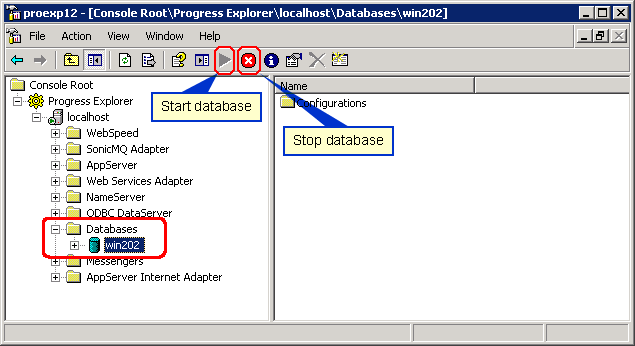
Configure the Database
Many of the database startup parameters can be set using the Progress Explorer Tool. Select "defaultConfiguration" under the win202 Configurations folder as shown below.
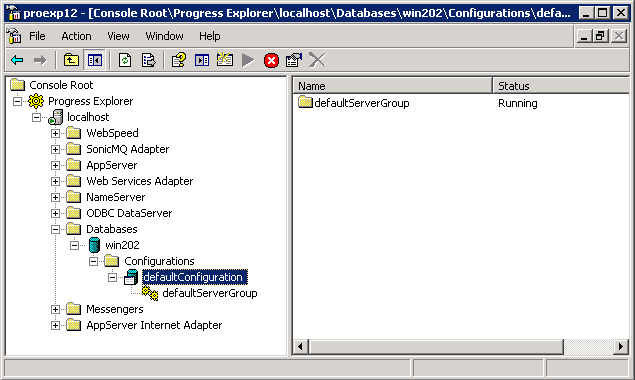
Right-click "defaultConfiguration" and select "Properties" from the menu to adjust settings. NOTE: Please contact Maine WIN-202 staff before adjusting any settings.
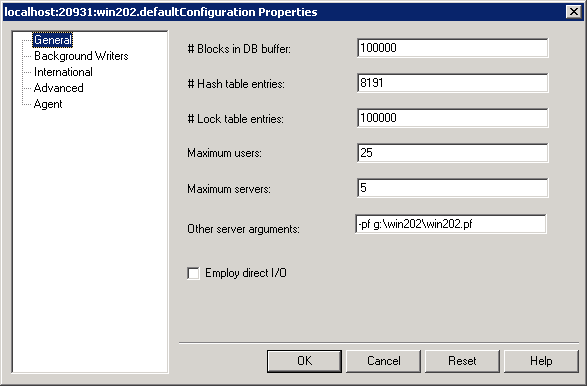
Scheduled Tasks
The Scheduled Tasks tool is used to start and stop the Batchmanager, schedule backups, cleanup archive files, run weekly extracts and various other administrative jobs. The "win202service" account is the database user name and is the user of the various administrative jobs run on the server.
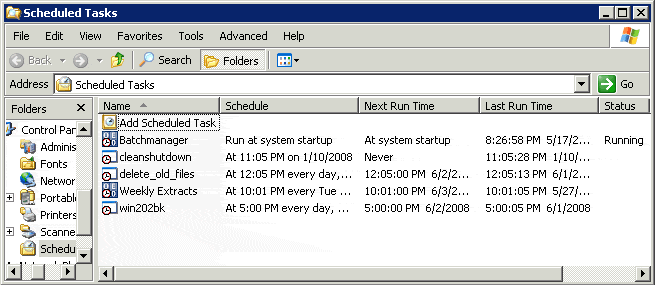
Right-click "win202bk" and select Properties from the menu. The database username is displayed in the "Run as:" field (see below figure). See the WIN-202 System Recommended Backup Procedures for more information.
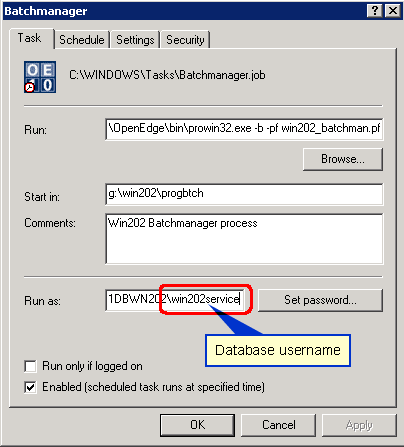
Stop and Start the Batchmanager
Right-click the Batchmanager task and click "Run" to start the batchmanager or "End Task" to stop the batchmanager. If the option is grayed out, it is currently enabled. Note: Always ensure the batchmanager is disconnected using Promon Option 5: Activity before launching it again. Running two instances of the batchmanager may cause database resource contention and cause jobs to crash.
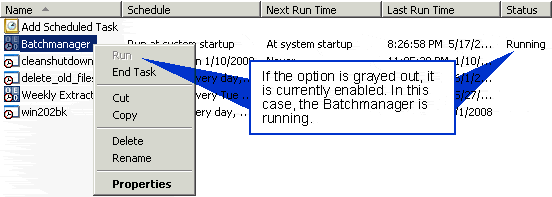
Note: Rebooting the server automatically starts the Batchmanager.
Scripted Shutdown
To shutdown the database programatically, create a batch file with the following command: c:\progress\openedge\bin\proshut <DBPATH\DBNAME> -by
Example: c:\progress\openedge\bin\proshut g:\win202\win202 -by
Control Files
Batchadm.txt
The batchadm.txt file exists on the server in the \win202 directory. This file is a log of system batch activity. Many programs are run on your server. The system looks at Batchmanager to see what programs are waiting to be run and runs them. It writes information back to the batchadm.txt file about when a program exited and if it aborted. This file can be opened with Notepad which is located in your "Accessories" folder in your Start Menu. ![]()
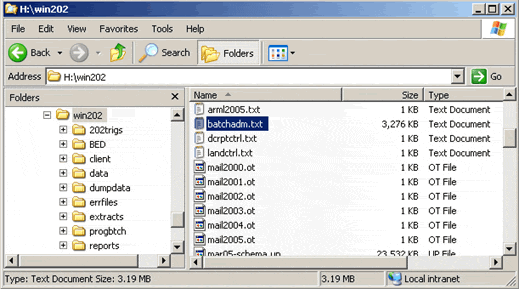
Open the batchadm.txt file in Notepad. In the an example below, the Batchmanager sat idle for a period of time and then ran the rollstrt-naics.p and the rollstrt-msa.p files. Note: It is not possible to determine whether the Batchmanager is still running just by viewing the batchadm.txt file; however, you can see what file was running if the Batchmanager crashes. Use the Promon Option 5: Activity on the server to determine whether a procedure has stopped the Batchmanager.
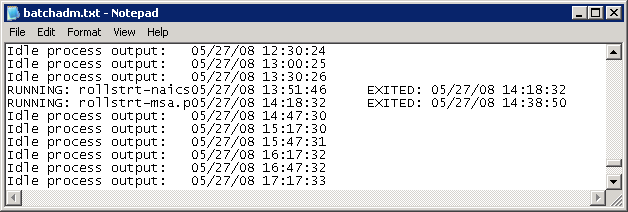
Note: The batchadm.txt file can grow very large. You can clean it out periodically by deleting the file. A new file will be generated when the batchmanager is started.
Rptctrl2.txt
The rptctrl2.txt file is located on the server in the \win202 directory (see example below). This file contains state dependent DJDE (printer control language) information that is used in the printing of Xerox forms. Currently, the file contains many lines of information, each with data pertinent to a specific printed form. Each state must modify this file or supply the developers with the appropriate information, so they can modify it. It is important the structure and setup of this file is not altered. Note: Do not delete any line, even if your state does not run that report.

Each form’s line information is shown below. ESCFRM is the name of our Xerox printer program. 001, 002 and 0251 are subprocedures within ESCFRM. K510DP, K509DP, K510GP, K509GP, K510EP, K509EP are fonts we use in Maine. BARBLS is the barcode font.
- "vm3023"
- "$DJDE JDL=ESCFRM,JDE=001,;"
- "$DJDE DUPLEX=YES,FONTS=((K510DP,9),(K509DP,9),(K510GP,12),(K509EP,10),(BARBLS,6)),;"
- "$DJDE FONTINDEX=(0,ONE),;"
- "$DJDE DATA=(1,110),ASSIGN=(1,1),;"
- "$DJDE FORMS=NVM1,END;" (NVM1 is the font page of the BLS 3023 VM form.)
- "$DJDE FORMS=NVM2,END;" (NVM2 is the back of page 1 instructions of the BLS 3023 VM form.)
- "$DJDE FORMS=NVM3,END;" (NVM3 is VM descriptions page subunit data f the BLS 3023 VM form.)
- "$DJDE FORMS=NVM4,END;" (NVM4 is the back of descriptions page when ending on odd numbers.)
- "vs3023"
- "$DJDE JDL=ESCFRM,JDE=002,;"
- "$DJDE DUPLEX=YES,FONTS=((K510DP,9),(K509DP,9),(K509GP,12),(K509EP,10),(BARBLS,6)),;"
- "$DJDE FONTINDEX=(0,ONE),;"
- "$DJDE DATA=(1,110),ASSIGN=(1,1),;"
- "$DJDE FORMS=NVS1,END;" (front page VS form)
- "$DJDE FORMS=NVS2,END;" (back page VS form)
- "ca3023"
- "$DJDE JDL=ESCFRM,JDE=002,;"
- "$DJDE DUPLEX=YES,FONTS=((K510DP,9),(K509DP,9),(K509GP,12),(BARBLS,6)),;"
- "$DJDE FONTINDEX=(0,ONE),;"
- "$DJDE DATA=(1,110),ASSIGN=(1,1),;"
- "$DJDE FORMS=NCA1,END;" (front page CA form)
- "$DJDE FORMS=NCA2,END;" (back page CA form)
- "mwrfrm"
- "$DJDE JDL=ESCFRT,JDE=0251,;"
- "$DJDE DUPLEX=YES,FONTS=((K510DP,9),(K509DP,9),(K510GP,12),(K510EP,8.5),(BARBLS,6),(K509DP,8.6)),;"
- "$DJDE FONTINDEX=(0,ONE),;"
- "$DJDE DATA=(1,110),ASSIGN=(1,1),;"
- "$DJDE FORMS=MWRP1,END;" (front page single sheet MWR form)
- "$DJDE FORMS=MWRP2,END;" (front page multi sheet MWR form)
- "$DJDE FORMS=MWRP3,END;" (subunit continuation page MWR form)
- "$DJDE FORMS=MWRP4,END;" (last page contact info MWR form)
- "ucfefrm"
- "$DJDE JDL=ESCFRT,JDE=0251,;"
- "$DJDE DUPLEX=YES,FONTS=((K510DP,9),(K509DP,9),(K510GP,12),(K510EP,8.5),(BARBLS,6),(K509DP,8.6)),;"
- "$DJDE FONTINDEX=(0,ONE),;"
- "$DJDE DATA=(1,110),ASSIGN=(1,1),;"
- "$DJDE FORMS=FEDP1,END;" (front page single sheet UCFE form)
- "$DJDE FORMS=FEDP2,END;" (front page multi sheet UCFE form)
- "$DJDE FORMS=FEDP3,END;" (subunit continuation page UCFE form)
- "$DJDE FORMS=FEDP4,END;" (last page contact info UCFE form)
A copy of our Xerox control file, ESCFRM, is shown below. States can set this program up either exactly as we have done, or they may integrate it into existing programs. It is important that the defaults be the same. Any font may be used, but it must be the same size as the one used in the programming (i.e., 10 characters per horizontal inch, fixed width, and six rows per inch). Please note that we have set up a block size of 2000; this is the block size Maine uses when we write the data onto tape, but states may use whatever they prefer. The program name used must match the name used in the variable data. When we write the file to tape, we block it but perform no conversion on the data. Please note that the file is in ASCII format not in EBCDIC.
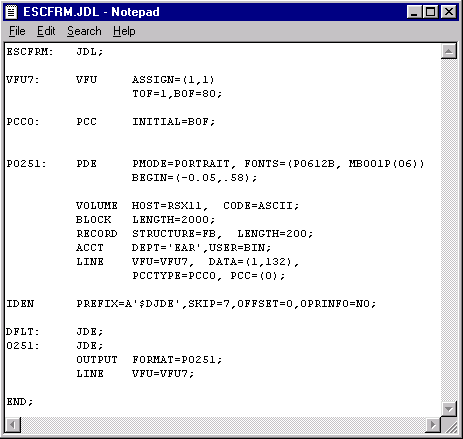
WIN-202 System Recommended Backup Procedures
Use Scheduled Tasks:
- The Online backup tracks ALL components of the database (extents, BI file, etc.) and backs up the database to a specific directory on the disk while the database is running.
- The process is fully automated by the "win202bk" bat file. Right-click the file to view its Properties as shown below.
- The database username is displayed in the "Run as:" field.
- The backup is scheduled to run daily at 5:00 PM.
- The "win202bk.up" backup file is generated in the probkups folder.
Backup to Tape:
- Write the "win202bk.up" file to tape. The specific directory containing the Progress Probackup is written off to tape each night (or more often if needed). On Friday, all disk drives are backed up to tape.
- This process can be automated by the use of a bat file and Task Scheduler. You need to change the tape in the A.M.
Example of Changing Tapes:
- There are 4 Quarterly tapes (1 for the last Friday at the end of each quarter), 2 Monthly tapes (for the last Friday of month 1 and month 2 of the quarter), 4 Weekly Friday tapes (for Friday, week 1, Friday, week 2, etc), and 10 Daily tapes (for Monday thru Thursday).
- On Monday thru Wednesday mornings, change the tape, record the date on the tape case, and place with the other tapes in order. On Friday insert a tape for the Monday morning backup.
- On Thursday, change the tape, record the date on the tape case, and do one of the following:
- When Friday will be the 1st Friday of the month, use Friday week 1 tape, when 2nd, use Friday week 2 tape, when 3rd, use Friday week 3 tape, and if a 4th that is not the last Friday of the month or quarter, use Friday week 4 tape.
- For the last Friday of the Month:
- If it is the 1st month of the quarter, use Month 1 tape, when 2nd month, use Month 2 tape, when 3rd month, use Quarterly tape (1-4).
